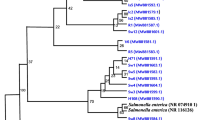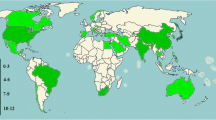Abstract
Bacteria from wastewater discharged to the sewerage near three hospitals of Islamabad, Rawalpindi, and Faisalabad were examined for resistance to the most commonly prescribed antibiotics in Pakistan. From the selected sites, a total of 109 isolates from 40 different species were identified based on 16S rRNA gene sequence and phylogeny. The isolates were tested for their resistance to ciprofloxacin, levofloxacin, ofloxacin, amoxicillin, and ampicillin. The results indicated that the isolates were resistant with the highest percentage to ampicillin and the lowest percentage to ciprofloxacin. Among the resistant isolates, 91.7% were found resistant to ampicillin, 83.5% to amoxicillin, 67.0% to ofloxacin, whereas only 27.5% to ciprofloxacin and 21.1% to levofloxacin. Among three sampled locations, the most of resistance was observed in Escherichia and Acinetobacter species. More than 30% isolated microorganisms were found resistant to more than three antibiotics. These findings concluded the presence of predominant microbial population resistant to antibiotics in wastewater channels near hospitals and its surroundings, which requires further investigation regarding their existence and spread in other environmental media having potential community health implications.




Similar content being viewed by others
References
Al-Joufi FA, Aljarallah KM, Hagras SA, Al Hosiny IM, Salem-Bekhit MM, Youssof AME, Shakeel F (2020) Microbial spectrum, antibiotic susceptibility profile, and biofilm formation of diabetic foot infections (2014–18): a retrospective multicenter analysis. 3 Biotech 10: 325. https://doi.org/10.1007/s13205-020-02318-x
Arshad M, Merlina G, Uzu G, Sobanska S, Sarret G, Dumat C, Silvestre J, Pinelli E, Kallerhoff J (2016) Phytoavailability of lead altered by two Pelargonium cultivars grown on contrasting lead-spiked soils. J Soils Sediments 16:581–591
Arshad M, Naqvi N, Gul I, Yaqoob K, Bilal M, Kallerhoff J (2020) Lead phytoextraction by Pelargonium hortorum: comparative assessment of EDTA and DIPA for Pb mobility and toxicity. Sci Total Environ 748: 141496.
Arshad M, Zafar R (2020) Antibiotics, AMRs, and ARGs: fate in the environment. In: Hashmi MZ (eds) Antibiotics and antimicrobial resistance genes in the environment. Elsevier, Inc. Netherlands. https://doi.org/10.1016/B978-0-12-818882-8.00009-7, pp 138–154
Bauer AW, Kirby WM, Sherris JC, Turck M (1966) Antibiotic susceptibility testing by a standardized single disk method. Am J Clin Pathol 45:493–496
Bengtsson-Palme J, Kristiansson E, Larsson DJ (2017) Environmental factors influencing the development and spread of antibiotic resistance. FEMS Microbiol Rev 42:1
Cattoir V, Poirel L, Aubert C, Soussy CJ, Nordmann P (2008) Unexpected occurrence of plasmid-mediated quinolone resistance determinants in environmental Aeromonas spp. Emerg Infect Dis 14(2):231–237
Daughton CG (2016) Pharmaceuticals and the Environment (PiE): evolution and impact of the published literature revealed by bibliometric analysis. Sci Total Environ 562:391–426
European Committee on Antimicrobial Susceptibility Testing (2017) European Committee on Antimicrobial Susceptibility Testing Breakpoint tables for interpretation of MICs and zone diameters. European Committee on Antimicrobial Susceptibility Testing
Feglo PK, Gbedema SY, Quay SNA, Adu-Sarkodie Y, Opoku-Okrah C (2010) Occurrence, species distribution and antibiotic resistance of Proteus isolates: a case study at the Komfo Anokye Teaching Hospital (KATH) in Ghana. Int J Pharma Sci Res 1:347–352
Gales AC, Jones R, Forward K, Linares J, Sader HS, Verhoef J (2001) Emerging importance of multidrug-resistant Acinetobacter species and Stenotrophomonas maltophilia as pathogens in seriously ill patients: geographic patterns, epidemiological features, and trends in the SENTRY Antimicrobial Surveillance Program (1997–1999). Clin Infect Dis 32:S104–S113
Giske CG, Monnet DL, Cars O, Carmeli Y (2008) Clinical and economic impact of common multidrug-resistant gram-negative bacilli. Antimicrob Agents and Chemother 52:813–821
Grenni P, Ancona V, Caracciolo AB (2018) Ecological effects of antibiotics on natural ecosystems: A review. Microchem J 136:25–39
Gul I, Manzoor M, Hashim N, Shah GM, Waani SPT, Shahid M, Antoniadis V, Rinklebe J, Arshad M (2021) Challenges in microbially and chelate-assisted phytoextraction of cadmium and lead–A review. Env Pollut 287: 117667
Gul I, Manzoor M, Kallerhoff J, Arshad M (2020) Enhanced phytoremediation of lead by soil applied organic and inorganic amendments: Pb phytoavailability, accumulation and metal recovery. Chemosphere 258:127405. https://doi.org/10.1016/j.chemosphere.2020.127405
Gul I, Manzoor M, Silvestre J, Rizwan M, Hina K, Kallerhoff J, Arshad M (2019) EDTA−assisted phytoextraction of lead and cadmium by pelargonium cultivars grown on spiked soil. Int J Phytorem 21:101–110
Holt H, Gahrn-Hansen B, Bruun B (2004) Shewanella species. Clin Microbiol Infect 10:348–349
Huang C-H, Renew JE, Smeby KL, Pinkston K, Sedlak DL (2011) Assessment of potential antibiotic contaminants in water and preliminary occurrence analysis. J Contemp Water Res Edu 120:4
Hujer KM, Hujer AM, Hulten EA, Bajaksouzian S, Adams JM, Donskey CJ, Thomson JM (2006) Analysis of antibiotic resistance genes in multidrug-resistant Acinetobacter sp. isolates from military and civilian patients treated at the Walter Reed Army Medical Center. Antimicrob Agents Chemother 50:4114–4123
Iqbal A, Arshad M, Karthikiyan R, Gentry TJ, Rashid J, Ahmed I, Schwab AP (2019) Diesel degrading bacterial endophytes with plant growth promoting potential isolated from a petroleum storage facility. 3 Biotech 9(1):35
Iweriebor B, Gaqavu S, Obi L, Nwodo U, Okoh A (2015) Antibiotic susceptibilities of Enterococcus species isolated from hospital and domestic wastewater effluents in Alice, Eastern Cape province of South Africa. Int J Environ Res Public Health 12: 4231–4246
Javed R, Ahmed I, Khalid N, Iqbal M (2017) Isolation, molecular identification and characterization of boron-tolerant bacterial strains from sewage treatment pond of Islamabad, Pakistan. Appl Ecol Environ Res 15:1211–1226
Kang C-H, So J-S (2016) Antibiotic and heavy metal resistance in Shewanella putrefaciens strains isolated from shellfishes collected from West Sea, Korea. Marine Poll Bull 112:111–116
Khan EA, Hafeez A, Ikram A (2018) Situation analysis report on antimicrobial resistance in Pakistan - findings and recommendations for antibiotic use and resistance. The Global Antibiotic Resistance Partnership (GARP), Pakistan. https://www.cddep.org/publications/garp-pakistan-situation-analysis
Kim S, Aga DS (2007) Potential ecological and human health impacts of antibiotics and antibiotic-resistant bacteria from wastewater treatment plants. J Toxicol Environ Health, Part B 10:559–573
Kümmerer K (2009) Antibiotics in the aquatic environment—a review—part II. Chemosphere 75:435–441
Li D, Yang M, Hu J, Zhang J, Liu R, Gu X (2009) Antibiotic-resistance profile in environmental bacteria isolated from penicillin production wastewater treatment plant and the receiving river. Environ Microbiol 11(6):1506–1517
Lyczak JB, Cannon CL, Pier GB (2000) Establishment of Pseudomonas aeruginosa infection: lessons from a versatile opportunist. Microbes Infect 2:1051–1060
Mubbunu L, Siyumbi S, Katongo C, Mwambungu A (2014) Waste water as reservoir of antibiotic resistant micro-organisms: a case of Luanshya waste water ponds. Int J Res Medical Health Sci 4(9):15-20
Maluping RP, Lavilla-Pitogo CR, DePaola A, Janda JM, Krovacek K, Greko C (2005) Antimicrobial susceptibility of Aeromonas spp., Vibrio spp. and Plesiomonas shigelloides isolated in the Philippines and Thailand. Int J Antimicrob Agents 25:348–350
Mavroidi A, Miriagou V, Liakopoulos A, Tzelepi Ε, Stefos A, Dalekos GN, Petinaki E (2012) Ciprofloxacin-resistant Escherichia coli in Central Greece: mechanisms of resistance and molecular identification. BMC Infect Dis 12(1):1-7
Moges F, Endris M, Belyhun Y, Worku W (2014) Isolation and characterization of multiple drug resistance bacterial pathogens from waste water in hospital and non-hospital environments. Northwest Ethiopia BMC Res Notes 7:215
Mukhtar A, Manzoor M, Gul I, Zafar R, Jamil HI, Niazi AK, Ali MA, Park TJ, Arshad M (2021) Phytotoxicity of different antibiotics to rice and stress alleviation upon application of organic amendments. Chemosphere 258:127353. https://doi.org/10.1016/j.chemosphere.2020.127353
Munita JM, Arias CA (2016) Mechanisms of antibiotic resistance. Microbiol. Spectrum 4:2
Newman M, Frimpong E, Asamoah-Adu A, Sampene-Donkor E (2006) Resistance to antimicrobial drugs in Ghana. The Ghanaian-Dutch Collaboration for Health Research and Development Project number 2001 (No. 5, pp. 8-26). GD/07. Technical Report Series
Pruden A, Pei R, Storteboom H, Carlson KH (2006) Antibiotic resistance genes as emerging contaminants: studies in northern Colorado. Environ Sci Technol 40:7445–7450
Ranjbar R, Farahani O (2017) The prevalence of plasmid-mediated quinolone resistance genes in Escherichia coli isolated from hospital wastewater sources in Tehran. Iran Iran J Public Health 46(9):1285–1291
Rath S, Padhy RN (2015) Prevalence of fluoroquinolone resistance in Escherichia coli in an Indian teaching hospital and adjoining communities. J Taibah Univ Medical Sci 10(4):504–508
Saima S, Fiaz M, Manzoor M, Zafar R, Ahmed I, Nawaz U, Arshad M (2020b) Molecular investigation of antibiotic resistant bacterial strains isolated from wastewater streams in Pakistan. 3 Biotech 10: 378. https://doi.org/10.1007/s13205-020-02366-3
Saima S, Fiaz M, Zafar R, Ahmed I, Arshad M (2020a) Dissemination of antibiotic resistance in the environment. In: Hashmi MZ (ed) Antibiotics and antimicrobial resistance genes in the environment. Elsevier, Inc., The Netherlands. https://doi.org/10.1016/B978-0-12-818882-8.00006-1, pp 99–116
Salam LB (2020) Unravelling the antibiotic and heavy metal resistome of a chronically polluted soil, 3 Biotech 10: 238. https://doi.org/10.1007/s13205-020-02219-z
Shah JA, Ashfaq T, Khan MS, Shah KH, Riaz N, Arshad M, Shah SH, Amin BAZ, Arfan M, Zhang Y, Bilal M (2021) Melia azedarach activated carbon and its novel TiO2 nanocomposite for chemisorption and photodecoloration of Reactive Orange 16: Isotherm and kinetic modelling. Curr Anal Chem 17:107–119
Tadesse DA, Zhao S, Tong E, Ayers S, Singh A, Bartholomew MJ, McDermott PF (2012) Antimicrobial drug resistance in Escherichia coli from humans and food animals, United States, 1950–2002. Emerg Infect Dis 18(5):741–749
Wahid F, Baig S, Bhatti MF, Manzoor M, Ahmed I, Arshad M (2021) Growth responses and Rubisco activity influenced by antibiotics and organic amendments used for stress alleviation in Lactuca sativa. Chemosphere 264: 128433
Wepener V, Van Vuren J, Du Preez H (2001) Uptake and distribution of a copper, iron and zinc mixture in gill, liver and plasma of a freshwater teleost, Tilapia sparrmanii. Water SA 27:99–108
Wu N, Qiao M, Zhang B, Cheng WD, Zhu YG (2010) Abundance and diversity of tetracycline resistance genes in soils adjacent to representative swine feedlots in China. Environ Sci Technol 44:6933–6939
Yadav A, Kumar R, Saikia R, Bora T, Arora D (2009) Novel copper resistant and antimicrobial Streptomyces isolated from Bay of Bengal, India. J Mycologie Médicale 19:234–240
Yelnik C, Cousens R, Raoult D (2013) CMI editorial report 2013. Clin Microbiol Infect 19(1):1–7
Zafar R, Bashir S, Nabi D, Arshad M (2021) Occurrence and quantification of prevalent antibiotics in wastewater samples from Rawalpindi and Islamabad Pakistan Sci Total Environ 142596 https://doi.org/10.1016/j.scitotenv.2020.142596
Zhang XX, Zhang T, Fang HH (2009) Antibiotic resistance genes in water environment. Appl Microbiol Biotechnol 82:397–414
Acknowledgements
Lab support from the Microbial Culture Collection of Pakistan (MCCP), Bio-resources Conservation Institute (BCI), National Agriculture Research Centre (NARC), Islamabad, Pakistan, is highly acknowledged. The authors are thankful to Ms Amna Iqbal from Federal Medical and Dental College, Islamabad, Pakistan, for critical input about the use of antibiotics and Dr. Shakil Ahmad, SCEE, NUST, Islamabad, Pakistan, for the support rendered during revisions.
Funding
This research was a part of a project funded by the Higher Education Commission, Pakistan, under NRPU project no. 20–4155/R&D/HEC/14.
Author information
Authors and Affiliations
Contributions
MF did the experimental work; RR and IA assisted in experimental work and preparation of the manuscript. IA, UN, and MA reviewed the manuscript and improved the discussion. MA (PI) obtained research funding, supported by IA (Co-PI).
Corresponding author
Ethics declarations
Conflict of interest
The authors declare no competing interests.
Additional information
Publisher's Note
Springer Nature remains neutral with regard to jurisdictional claims in published maps and institutional affiliations.
Rights and permissions
About this article
Cite this article
Fiaz, M., Ahmed, I., Riaz, R. et al. Prevalence of antibiotic-resistant bacterial strains in wastewater streams: molecular characterization and relative abundance. Folia Microbiol 66, 1023–1037 (2021). https://doi.org/10.1007/s12223-021-00902-z
Received:
Accepted:
Published:
Issue Date:
DOI: https://doi.org/10.1007/s12223-021-00902-z




